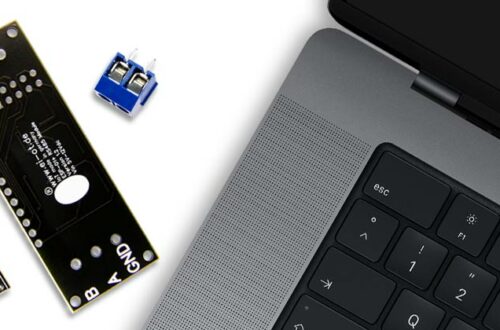EI-OT RS232 Module dual mode connection  |
Insofern keine GPIO Konfiguration festgelegt wurde, wird innerhalb der Tasmota Firmware GPIO1 als UART TX und GPIO3 als UART RX definiert. Im nachfolgenden Beispiel wird zusätzlich GPIO4 als serBr TX und GPIO5 als serBr RX (zweite RS232 Schnittstelle mittels Tasmota Hardware Bridge) verwendet.
Als Hardware werden 2 echte CP2102 RS232 Level Konverter verwendet, sollten beispielsweise USB/TTL Konverter verwendet werden erfolgt zwar eine Kommunikation, jedoch erscheinen unleserliche Zeichen im seriellen Terminal (da das EI-OT RS232 Modul echten RS232 Level liefert).
Ferner wird ein entsprechender serial Terminal benötigt, im nachfolgenden Beispiel Roger Meier’s Freeware CoolTerm. |
If no GPIO configuration has been specified, GPIO1 is defined as UART TX and GPIO3 as UART RX within the Tasmota firmware. In the example below, GPIO4 is also used as serBr TX and GPIO5 as serBr RX (second RS232 interface using Tasmota Hardware Bridge).
Two real CP2102 RS232 level converters are used as hardware. If, for example, USB/TTL converters are used, communication takes place, but illegible characters appear in the serial terminal (since the EI-OT RS232 module delivers real RS232 level). |
Tasmota RS232 Module dual mode example  |
Nachdem wie oben benannt
- eine entsprechende RS232 Verbindung hergestellt wurde
- ein serieller Terminal auf vorgenannte RS232 Verbindungen mit einer baudrate von 115200 b/s (8n1) zugreift
kann wie nachfolgend beschrieben direkt über Tasmota auf RS232 kommuniziert werden
- gebe in die Tasmota Kommandozeile SerialSend1 gefolgt von einem String ein
Drücke die Enter Taste
- der String wird direkt über UART auf die RS232 Schnittstelle ausgegeben und erscheint im seriellen Terminal der ersten RS232 Schnittstelle
- gibt man nun einen String im seriellen Terminal ein und sendet über die RS232 Schnittstelle, so erscheint in der Tasmota Console SerialReceived gefolgt von dem gesendet String
- gleichermassen kann über die zweite RS232 Schnittstelle über die Tasmota Console gesendet werden. Hierbei gilt zu beachten das der Tasmota Befehl nun SSerialSend1 lautet gefolgt von dem zu sendenden String,
- beim Drücken der Taste ENTER wird der String direkt über die zweite (diesmal GPIO4 und GPIO5) RS232 Schnittstelle übertragen und erscheint im seriellen Terminal der zweiten RS232 Schnittstelle
- sendet man nun einen String vom seriellen Terminal, so erscheint dieser in der Tasmota Console SSerialReceived gefolgt von dem jeweiligen String.
Weiterführende Informationen zum von Tasmota unterstützten Protokoll.
|
After as named above
- a corresponding RS232 connection has been established
- A serial terminal accesses the RS232 connections with a baud rate of 115200 b/s (8n1).
can be communicated directly via Tasmota thru RS232 as described below
- Enter SerialSend1 followed by a string in the Tasmota command line
Press the Enter key
- The string is output directly via UART to the RS232 interface and appears in the serial terminal of the first RS232 interface
- If you now enter a string in the serial terminal and send via the RS232 interface, SerialReceived appears in the Tasmota Console followed by the sent string
- Likewise, it can be sent via the Tasmota Console via the second RS232 interface. Please note that the Tasmota command is now SSerialSend1 followed by the string to be sent,
- When you press the ENTER key, the string is transmitted directly via the second (this time GPIO4 and GPIO5) RS232 interface and appears in the serial terminal of the second RS232 interface
- If you now send a string from the serial terminal, it will appear in the Tasmota Console SSerialReceived followed by the respective string.
Further information on the protocol supported by Tasmota. |






